Our holiday trip to the UK was cold but beautiful. We mixed a city of earthen tones punctuated by red buses with a countryside full of every shade of green. And good food everywhere we went.
This time Paul booked a late afternoon flight, which meant we arrived in the UK in the afternoon of the next day and only had to power through dinner before we collapsed. It might have worked if we had been in business class and really slept. So although I didn’t crash upon arrival, I was fuzzy for the better part of a week. We took the bus from Heathrow to Victoria Coach Station, which was more fun than the tube because we could see the sights. And it took us right to our hotel, which was at the edge of Belgravia.
The idea of hospitality and service in hotels has not reached down to the midpriced boutique hotels. But in the middle of winter, you are just glad that they left the heat on. Because it gets dark and frigid in December. When you wake up from an afternoon nap, it’s already nighttime. After we unpacked, we strolled the neighborhood and came across a marvelous shop just across the street. It looked fantastic, but we weren’t altogether sure what it sold. Turned out it was the shop of the genius milliner Philip Treacy.
 |
| Saatchi Gallery |
We wandered over to the Duke of York’s Headquarters (constructed in 1801, it was once a school for the children of soldiers’ widows, and later some German spies were court-martialed there), which was converted to the latest version of the Saatchi Gallery in 2008. It’s a stunning building, but the exhibition entitled Body Language was disappointing. In the exhibition New Order: British Art Today, there was one artist I liked, Sara Barker, whose delicate metal and lightly painted canvas sculptures divided space and invited inspection. And the famous oil installation by Richard Wilson, 20:50, has been reconstructed in the new building. (Photos of all three variations can be seen on the Saatchi website.) I loved watching visitors walk in and try to figure out what they are looking at… Eventually the scent of oil, although not overwhelming, gives you a hint.
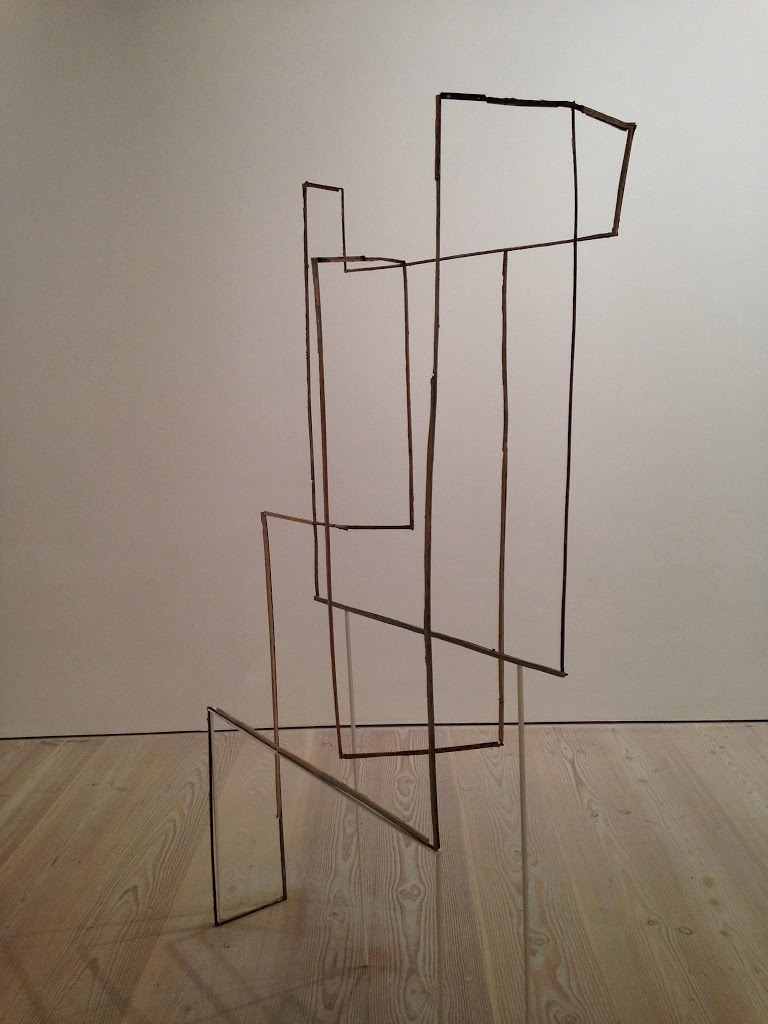 |
| Sculpture by Sarah Barker |
 |
| Richard Wilson’s 20:50 |
We were lucky to find a decent restaurant next door to our hotel, as it had begun to rain. From our vantage point, Christmas was mostly an excuse to meet up with old friends and share a drink or a meal, and not an orgy of bad candy, complex toys, and useless kitchen gadgets. This turned out to be the case among the adults in Paul’s family, if not the kids, which is one reason we like going there so much.
Paul loves taking the bus in London, even if it takes longer than the tube. We got up at a normal time, walked around the corner, and caught the bus to Somerset House. Our young pal Carlos is spending the semester at the Courtauld Institute of Art, which is just across the courtyard. We should have stopped in to see their collection, too.
We were lucky to get on one of the buses designed by Thomas Heatherwick, a brilliant young industrial designer best known for the Olympics torch. Unlike the older double deckers, the new model has two staircases, and everything has been thought through, from the swerve of the wraparound glass to the incised pattern in the rubber floor and staircases. We were doubly lucky because the front seat was open upstairs. As we turned every corner, I was like an eager puppy with every new vista of Westminster or Big Ben or other landmark I’ve only seen from the street. The perception is distorted just enough that you feel like you are going to mow down the errant pedestrian. The streets are tight.
 |
| New double-decker bus |
Somerset House hosts all kinds of art shows—not that they always make sense together. Upstairs, they hung the famous Sandham Memorial Chapel paintings by Stanley Spencer, which have been removed while the chapel is being renovated. While they are interesting pieces of postwar art, they didn’t have anything to do with the show I wanted to see: Isabella Blow: Fashion Galore! Isabella Blow is credited with discovering both Alexander McQueen and Philip Treacy. She was born into the end of an aristocracy. Lots of entitlement and no money. Apparently, she bought out McQueen’s entire first collection but didn’t have the money to pay for it, so like the rest of us, she went on the installment plan. The show didn’t reveal a lot about her as a person, but it did show the clothes, hats, and fashion shoots that she had a hand in.
 |
| Isabella Blow: Fashion Galore! |
In most European cities, we have a pattern of heading out early in the morning after a large breakfast, skipping lunch (or eating very lightly), and then taking a nap before our late afternoon and evening expedition. Scheduling tea during the holidays takes a great deal of planning. Claridges, the Connaught, and the Berkeley were all full, but Paul found a jewel box of a tea room in the Capital Hotel just down from Harrod’s. Maybe slightly less elaborate than a fashion designer-inspired tea we had several years ago at the Berkeley, but sufficient to cover us for lunch and dinner! Paul’s fellow composer pal Cecilia McDowall updated us on her many commissions and performances in the US.
 |
| Tea room at Capital Hotel |
With a short break, we then departed for St. John’s Smith Square, which is a deconsecrated church from 1728 that was firebombed during the war and restored. It now serves as a performance venue. The Cardinall’s Musick, the group that sang Paul’s premiere in Orkney in 2012, was giving a concert. In addition to hearing the beautiful music, afterwards we got to hang out and share a bottle of wine with director Andrew Carwood and singer Patrick Craig (and his folks). Patrick is one of the funniest choral singers I’ve ever met. He could be a standup comic.
We woke up early the next day and headed out to Borough Market, which is like San Francisco’s Ferry Building but funkier. It’s on the south side of London Bridge and reminds me of an authentic Dickens Christmas Fair. Our destination was the cheese shop, Neal’s Yard Dairy. As they say in the UK, “Oh, that was dear.” But these were some of the best cheeses we’ve ever eaten. For an early lunch, we ducked into a place called Elliot’s, which had a warm proprietor and good food, but suffered from the usual mediocre service.
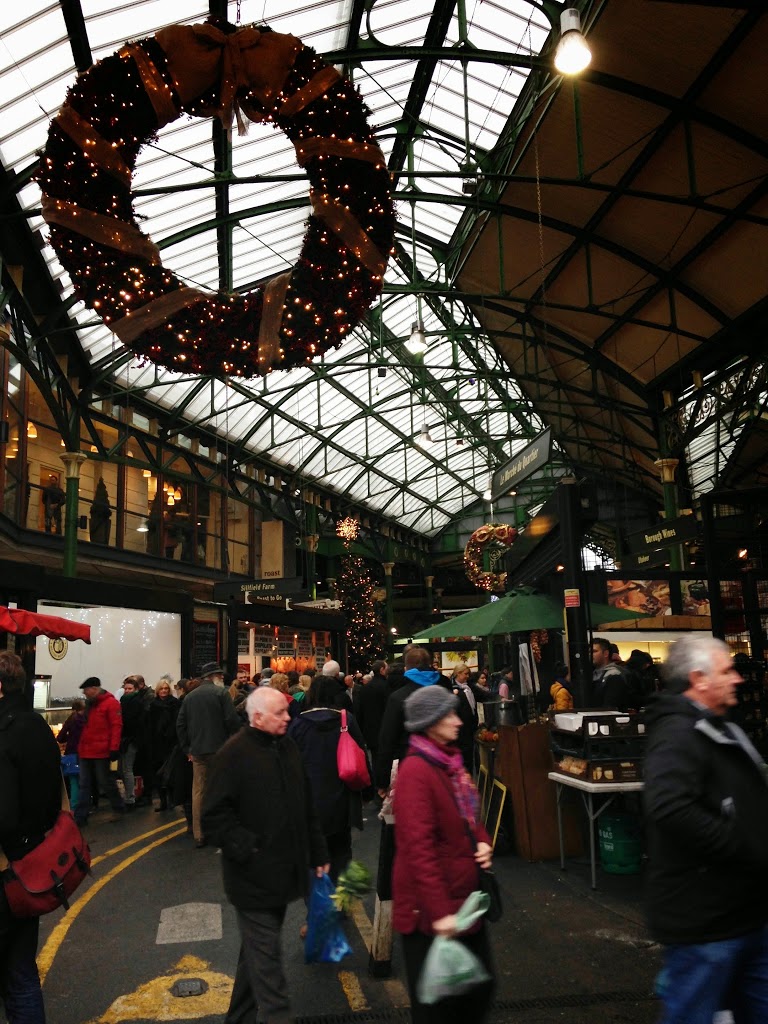 |
| Borough market |
The train to Rugby (where Paul was born and near where the family still lives) takes just over an hour from Euston Station. After we got off the escalator at the train station, Paul pointed out a bench and said, “That’s the spot where I once spent the night when I missed the last train when I was a teenager.” One day it will have one of those blue ceramic plaques: “Composer Paul Crabtree slept here.” Euston is one of those modern monstrosities of the postwar era. It looks like something from the USSR’s modern bureaucrat period. Our tendency is to arrive early for planes and trains. But there is hardly anyplace to sit, and the cafés couldn’t be any more dreary. There is a growing movement to save modernist buildings in the UK, but I hope they tear this one down.
Paul sprung for first class, which would have been fine, but some interlopers snuck into our section, which brought out my usual class conflicts. I wanted them thrown out! Within a minute of coming downstairs into the new waiting area at Rugby Station, we saw Aunt Jenny’s beaming face and were whisked back to Orchards.
Graham and Jenny’s house has two hearts. One is the garden where Graham can be found almost every day except for the rainiest days of winter, and the other is the kitchen, where the heat is always on and something is always being planned, prepared, or “tidied up.”
The big change in the kitchen is a new range top that is electric but works like gas. Instant heat, and it turns off when you remove a pot so the grandkids don’t get burned. There have been a few changes in the garden since our last visit. But the biggest change is in the view of the garden. Graham had a ribbon window installed along one side of the lounge. It’s so big that it required a new steel beam and steel posts. When he first suggested this, I thought it might be too much view all of the time, but I was wrong. It is especially useful in the winter, when it’s so cold that most visitors don’t want to spend more than a few minutes outside. The orchard has been trimmed and a few birches around the pond removed. There is also a mound to create more of a middle-ground view. In the immediate foreground is a canal or moat around the living room windows. Like a circular water feature, this offers an upside-down view of the tall trees.
 |
| The new window at Orchards. |
Peace was quickly disrupted by all of the cousins in what they call a GnT flash mob. This is the only family I’ve ever spent time with that resembles a rolling party, with members from every age group. After one cocktail, we all had to rush off to church for a caroling service. In this case, church was a 15th-century stone structure just a mile away in Kimcote. Right out of a British mystery, complete with bell ringers and their furry ropes. This congregation installed beer garden–type heaters to keep the faithful warm. We all joked that it was like the TV show Midsomer Murders and that we should find a body just as we were leaving.
 |
| Christmas singing at Kimcote |
The next day, our pals Joanna and Tony from Wales came by for lunch. There were tales of Greece (and why it was a mistake for it to join the EU) and Joanna’s family burning down a campsite. Joanna also brought Paul’s beautiful Christmas present, a slender porcelain tower, which took some doing to sneak into the house!
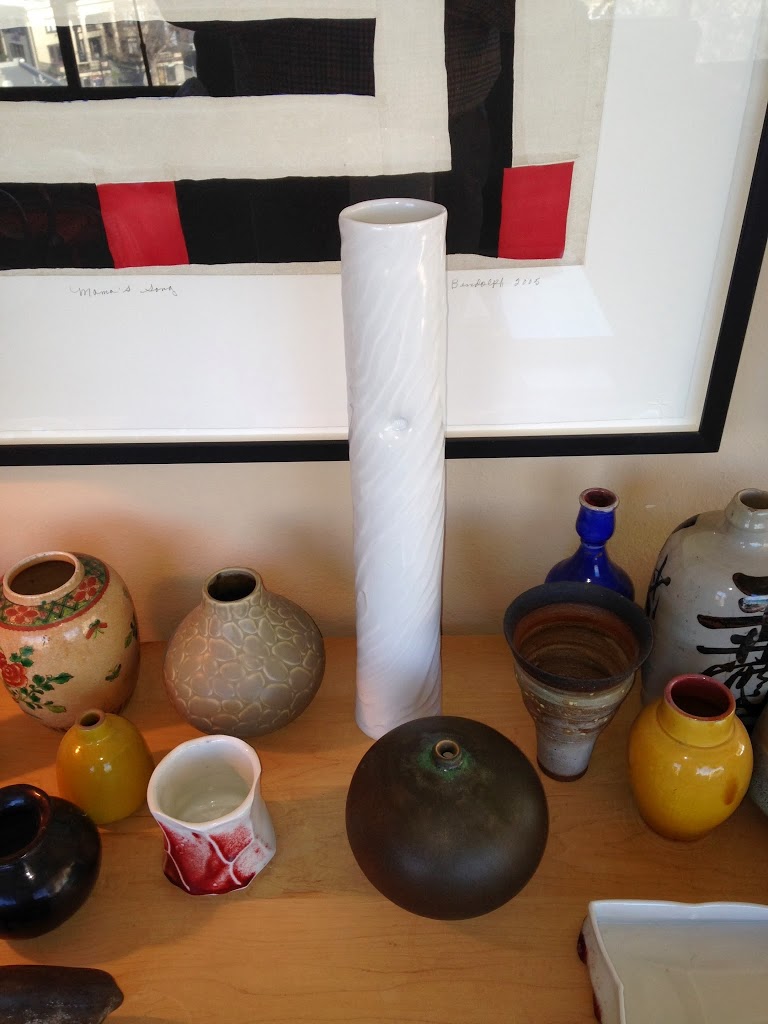 |
| Christmas gift: vase by Joanna Howells |
The next few days were spent eating, drinking, singing, and opening presents at cousin Jane’s. Her husband, Paul, has become quite the cook. The entire family gathered for Christmas Eve and Christmas Day. We sang, ate, laughed, and teased with the affection that closeness brings. It was as Christmas should be.
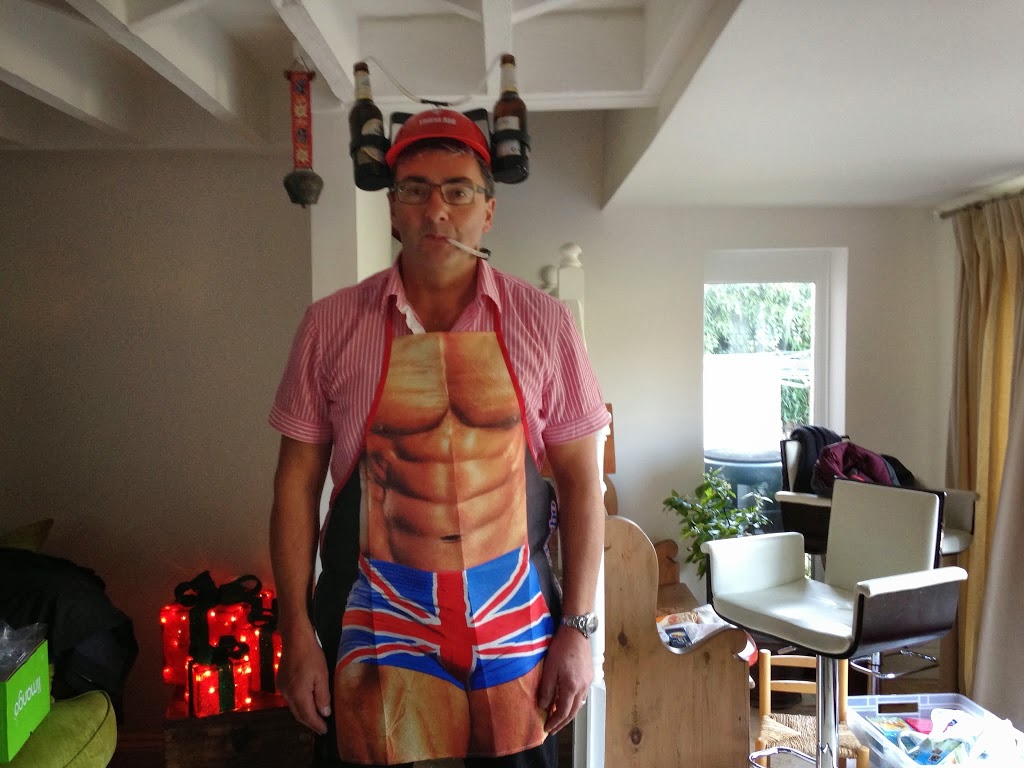 |
| Paul Collins in his dream apron with emergency beer supply helmet. |
 |
| Dominic Collins with his Christmas cap on. |
 |
| Cozy Christmas |
Following a relatively quiet Boxing Day, we ventured to Stoke Goldington to see James and Emily Chua and their wonderful daughters and cousins. James is a retired architect who has built a large private garden defined in large part by stone walls that he made by hand. He fells dead trees in a neighboring farmer’s wood and then hand-saws them into specific lengths to heat his home. In the middle of summer, the sun and the small efficient fireplaces heats the entire former barn. One of their daughters is an architect and the other a musician. So there was a lot to talk about. This year it didn’t rain, so we got to see the garden at leisure. A perfect day in the country.
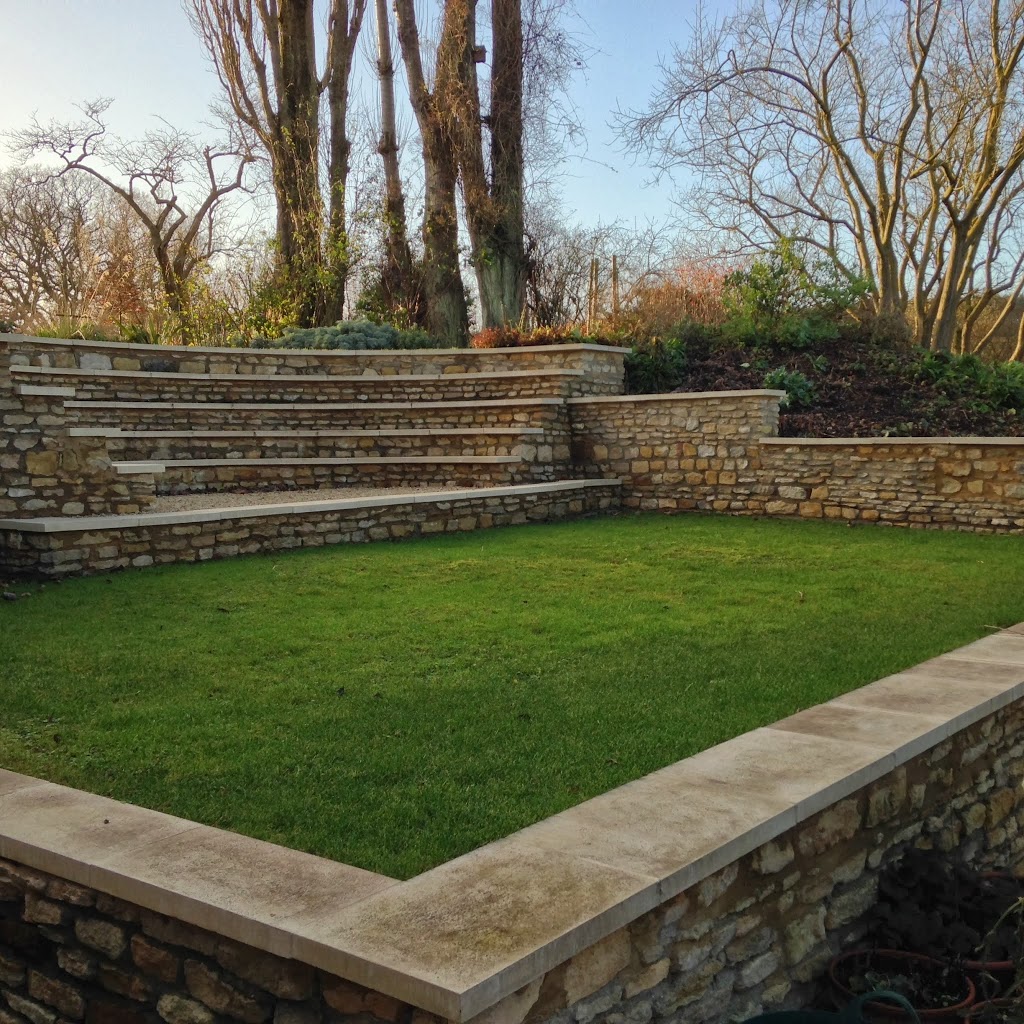 |
| The Chua Garden in Stoke Goldington |
When we returned to London, we stayed in Belsize Park, a neighborhood known to fans of Elizabeth George as the home of Detective Sergeant Barbara Havers. It’s a bit more upmarket than it used to be, but it ain’t Belgravia. However, it is home to the actor Sir Derek Jacobi (remember Claudius?), who sat a few seats away from us at the theater. We had to stand in line only a few minutes at the TKTS booth in Leicester Square to get fifth-row seats to Ibsen’s Ghosts, which was some of the best theater either had us in seen in a long time. The set designer uses invisible walls to give the illusion of a manor house on the narrow stage.
 |
| Our hotel in Belsize Park |
We also had a good long visit at the Victoria and Albert Museum, where we focused on modern ceramics. Found some by Robin Welch, a potter whose work I bought on a whim 20 years ago. The highlight was seeing the work of potter Lucie Rie and her reconstructed studio. The gift shop revitalized my interest in the Festival of Britain and all it did for modern British design. I feel another post coming on…
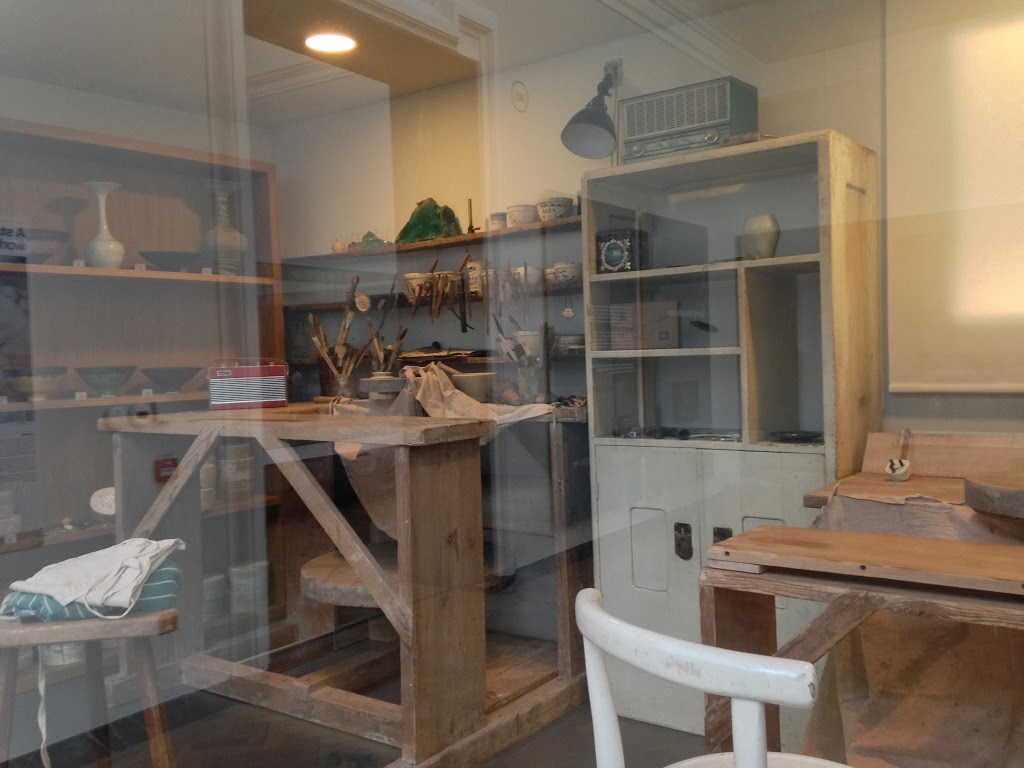 |
| Lucie Ries reconstructed studio in the V&A |
When Paul started to get crabby and threatened to get a sandwich from Marks & Spencer, I went into high gear and quickly secured a table at a Lebanese restaurant on Brompton Road. Looking at the prices, I figured the small plates would be, well, small. The servers must have thought, “Those grotesque Americans,” as we ordered more falafel than the table could hold. It was embarrassing. Later in the day, we ventured down to Battersea to have dinner with Paul’s pal Paul Hughes. Another new neighborhood. We had to walk through a public housing project to get there, but we found out it wasn’t dangerous at all.
If anything is going to get me to live in England (well, part-time in the summer, anyway), it might be a cottage in the countryside. On our last full day, we took the train from Victoria (which feels like a proper train station, unlike Euston) down to Kent to visit Alasdair and David’s new home in Faversham, Rose Cottage. If I understood correctly, the cottage was originally built for one of the gardeners on the local estate. For various reasons, Alasdair and David ended up with an acre of land that spreads out from their dwelling. They already have a tractor to mow the lawn! We are excited to come back in the summer for one of those lengthy, boozy picnics the Brits have to celebrate the brief appearance of the sun. David has a talent for sourcing great home design products that are both cottagey and contemporary. They have given us a tea towel from Lush Designs, and if I had a cottage, I would have their fabrics and lampshades everywhere.
 |
| The sky from Faversham, Kent |
Hope to return in the spring and see everybody again at the Bath Festival!
More info can be found at:
www.saatchigallery.com
www.somersethouse.org.uk
www.grahamsgreens.com
www.lushlampshades.co.uk
www.bathfestivals.org.uk
www.joannahowells.co.uk


